
A Flash in the pan!Įver since it was introduced in 1996, Flash has been revolutionary in helping shape the internet and brands we know today from basic static websites to a more multimedia experience. If there are no alternatives, consider reaching out to the LX.lab to start planning the build of your learning activities using the guidelines presented above. If Flash is used, you will need to investigate other resources or applications as soon as possible. If you are directing students to use any applications or interactive websites hosted outside UTS, check that they are no longer using Flash-based components by either testing it in your browser with Flash disabled, checking support pages, or confirming with the website owners. GoAnimate now known as Vyond, Flash-free since 2018) may also include Flash-based interactives, animations or videos. Third-party applications and websites (e.g. This will ensure that your learning activity stays relevant with modern technologies and is meeting your learner needs. It is highly recommended that even if your old SCORM packages continue to work in Canvas that you plan to recreate these in Canvas in the near future.

Attend training or book a consultation with the LX.lab to learn how UTS-supported learning tools may be used to assist with the new build.This will help you contextualise the activity and see the bigger picture prior to build. Draft a storyboard/plan for the activity.Check/request for permission to use the educational materials if this is not owned by UTS.Locate and gather all the original source materials used within the SCORM package (JPEGs, MP4s etc.).Review the SCORM activity and identify areas for improvement based on your subject’s intended learning outcomes.To help you get started, please follow these guidelines: Depending on your requirements, you may need to use a combination of these technologies in your Canvas subject site. If they fail, you will need to look at migrating these into a UTS centrally supported tool, such as H5P (interactive authoring tool) or Kaltura (video streaming tool). If they work, it is likely that you can continue to use these in Canvas SCORM. To disable in Firefox and Chrome, simply change the permission settings so that Flash does not activate automatically. If you do need your subjects’ SCORM packages, test them by disabling the Flash Player extension in your browser and then running the package. It’s important to store source materials independently to ensure that they can be used in future applications.
#Adobe flash how to get for free 2016 archive#
If a SCORM package is discovered and deemed to be no longer necessary, archive it with the original source materials (JPEGs, MP4s etc) and store in a secure location like SharePoint.
You can double check by enabling it via the ‘Navigation’ tab in your course settings. In Canvas, you can check the ‘SCORM’ menu located in your course navigation panel – if this is not visible, it’s likely you don’t have SCORM packages. To check whether you use any SCORM packages in UTSOnline, go to ‘Evaluation > SCORM Reports’ in the ‘Subject Management’ menu.

Pre-2016 packages may be based on Flash technology so it’s advised that you check whether your subject site has any SCORM packages and, perhaps even more importantly, evaluate whether they are still required. SCORM packages can be built using either HTML5 or Flash. To ensure that students continue to receive high-quality online learning experiences, the LX.lab has put together this advice for dealing with Flash’s demise – and, as always, check in with us if you need further help or advice. This content could be an interactive video or slides created on programs such as Captivate, Articulate etc or simply an interactive game online – see Adobe’s showcase gallery for more examples. Distribution and support will stop from December 31st, meaning that any e-learning content using Flash will soon cease to be compatible with today’s modern technologies. In a few short weeks, Adobe Flash will be retiring.


 0 kommentar(er)
0 kommentar(er)
